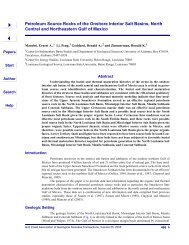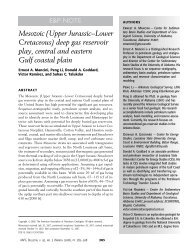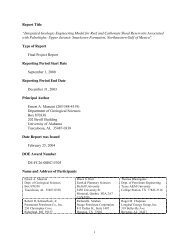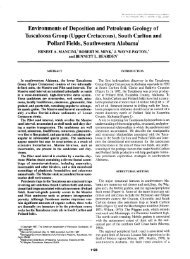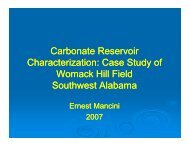Part 4 - Berg - Hughes Center
Part 4 - Berg - Hughes Center
Part 4 - Berg - Hughes Center
Create successful ePaper yourself
Turn your PDF publications into a flip-book with our unique Google optimized e-Paper software.
2,000 to 2,500 ft with net pay of 10 to 70 ft. The porosity of the reservoir is from 5 to<br />
25% and permeability can be as high as 500 md (Bebout et al., 1992).<br />
Tertiary Paleocene-Eocene (Midway, Wilcox)<br />
Midway Group<br />
According to Murray (1955), the end of the Cretaceous is characterized by an<br />
interruption of deposition, accompanied by withdrawal of the seas, resulting in a<br />
widespread regional unconformity at the base of the Paleocene in the Coastal Plain<br />
province. Before the Cretaceous seas withdrew, they covered all of the Coastal Plain and<br />
much of the Central Interior of North America. Continued retreat of the early Tertiary<br />
seas in the Coastal Plain area is also evident because of appreciable quantities of later<br />
Midwayan, shallow-water, lignitic, arenaceous to argillaceous, marginal marine deposits.<br />
In outcrops from eastern Texas, Rainwater (1964) identified the Midway as including<br />
shallow marine to moderately deepwater environments consisting of prodeltaic marine<br />
silts and clays that are very carbonaceous and with marine fossils.<br />
Alexander (1935) in a study of well cuttings from wells drilled in southwest<br />
Arkansas and northwest Louisiana was able to identify the Midway section based upon<br />
his correlations of ranges of foraminifera. The only microfossils observed by Alexander<br />
(1935) in the upper, silty, non-calcareous Midway shales of this region are small species<br />
of Ammobaculites and Spiroplectammina. Highly calcareous shales, commonly marly or<br />
chalky in character, and rich in microfauna, are usually encountered within a few feet,<br />
after the first hyaline foraminifera appear. Cores from the Midway in Bossier and<br />
Webster Parishes, Louisiana, were also used to recognize and describe the lower part of<br />
the Midway Group as predominantly calcareous, with true chalk occurring as lenses in<br />
380




